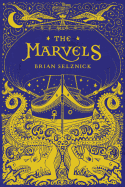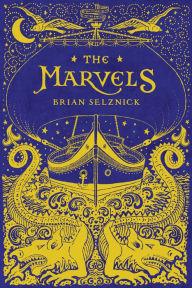
 Brian Selznick (The Invention of Hugo Cabret; Wonderstruck) once again merges a visual and textual story line, with themes of family and a search for home, to deliver an emotional wallop at the finish.
Brian Selznick (The Invention of Hugo Cabret; Wonderstruck) once again merges a visual and textual story line, with themes of family and a search for home, to deliver an emotional wallop at the finish.
The first nearly 400 pages of images lead readers through five generations of a theatrical family, the Marvels. In 1766, aboard the Kraken, an American whaling ship, a performance takes place on deck under a crescent moon. Selznick uses the skills he's developed in toy theater and puppetry to zoom in for detailed graphite drawings of the face of a girl tied to the mast being attacked by a dragon, and an angel who comes to save her. He then pulls back to give the audience a landscape view of an approaching storm. His cinematic pacing is as compelling as a great actor's timing.
The storm causes the fall of the angel from a great height, as well as the wreck of the ship. The only survivors are the actors who played the angel and the girl, and a small white dog, who wash up on shore.
Through the next nearly wordless pages, readers discover that the girl character was played by a boy actor, and his older brother dies of complications from the fall. ("Here lies my brother Marcus, an angel," reads the makeshift tombstone.) A British ship rescues the boy and his dog, and they wind up in London at the Royal Theatre. Billy Marvel (his name is revealed in a newspaper account) is soon adopted by the stagehands. Selznick's images elegantly reflect the passage of time, as Billy matures and raises a foundling (whom he names for his brother) who grows up to be an actor, marries and fathers a son named Alexander, a troubled actor. Alexander's son, Oberon, becomes an actor and has a son, Leontes, whose story ends abruptly when he attempts to rescue his grandfather from the burning Royal Theatre.
Flash forward to 1990 London, where 13-year-old Joseph Jervis has fled boarding school. Joseph's journey to connect with his uncle, Albert Nightingale, comes with mystery, surprises and another kind of theater altogether. Albert is obsessed with keeping his home in London's East End, a house that feels "like a puzzle," preserved as an exact moment in time. Joseph feels driven to solve the riddle that is his uncle, and enlists the help of Frankie, a neighbor girl whose own story connects to Uncle Albert's. A cache of audiotapes recaps the stories readers learned in the first 400 pages (which seems unnecessary but does not detract from the overall emotional impact of the book). When Joseph and Frankie learn from the Royal Theatre's "unofficial historian" that his version doesn't synch with the stories they've heard, it leads to a catharsis. Joseph realizes that life is "miracles and sadness, side by side."
Selznick asks readers to examine what we know versus what we want to believe, and what defines a family and makes a home. --Jennifer M. Brown, children's editor, Shelf Awareness
Shelf Talker: Caldecott Medalist Brian Selznick explores what it means to find safety and family in unexpected places.

